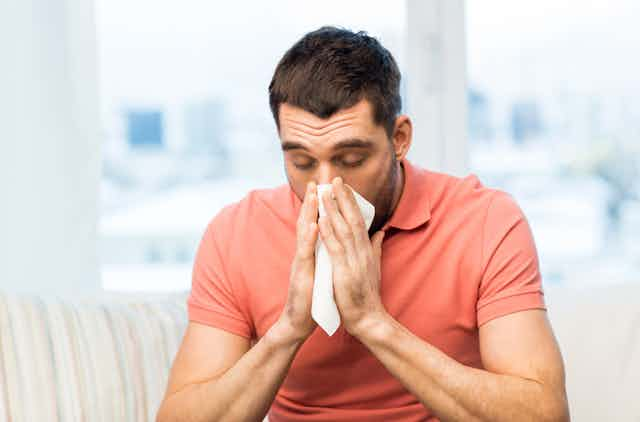Homes are germy places. Microbes come from a variety of sources such as ventilation systems, plants, the outdoor environment and our own microbial cloud. Usually, they pose no threat to our health and you need not worry.
When someone contracts a respiratory virus, such as influenza, you might want to reevaluate the situation to keep others safe from illness.
So how do you evacuate those flu germs from your home and workplace?
The best way is to follow a process known as infection prevention and control. It’s been used for decades in health care to keep patients, visitors and staff safe. All that’s required is a change of mindset: You must view the home like a hospital.
Then, by following a few easy steps, you can reduce the chances of the infection spreading to everyone who lives in, or enters, your home.
Stop touching your face
The first step in the process is to determine how the pathogen of interest spreads. For influenza, there are two well-known routes. The first is direct transmission from one person to another via droplets and possibly through the air.
The other is indirect transmission in which people inadvertently infect themselves after touching contaminated surfaces, sometimes called “fomites.”

Which route is most likely to contribute to infection spread? Direct may seem the obvious choice. But research has shown indirect transmission may be a significant contributor to an outbreak.
That’s because humans have a habit of regularly touching their faces, increasing chances for the introduction of the virus.
Use steam to kill flu
The next stage involves figuring out methods to prevent and/or control the routes of infection.
The easiest option is to eliminate spread by keeping infected people away from areas where healthy ones tend to congregate. But, unlike in a hospital, isolation is not usually possible — or ethical — in the home.
The only option then is to reduce the likelihood of self-inoculation by killing the virus on surfaces, a practice known as disinfection.
Disinfection is different from general cleaning as it is designed to kill certain types of microbial species. In health care, disinfectants are regulated and approved by governments and offer specific killing claims. However, the same cannot be said for consumer products and they may not be as effective as needed.
Thankfully, killing influenza can be achieved by wiping with simple detergents, diluted bleach, or hydrogen peroxide.
If chemicals are not desired, flu also dies in the presence of steam, a fact known for well more than 100 years.
Disinfect the TV remote
After choosing a disinfectant, the final step involves identifying the surfaces to clean. Those of greatest concern are “high-touch surfaces” — those that are touched on a regular basis by many individuals.
In hospitals, these include bed rails, tables and carts. In the home, high-touch surfaces also exist such as refrigerator and microwave handles, faucets, light switches, door knobs, the toilet and, not surprisingly, the TV remote control and other electronic devices.

All of these are prime sources for virus contamination and need to be disinfected regularly.
Of course, regularly is an arbitrary term. To know how often to disinfect, you need to understand the pathogen’s ability to stay alive in the environment. Experiments with influenza reveal the virus can remain infectious on surfaces for up to 24 hours.
This means you should disinfect as often as possible while an individual is showing symptoms and, to be safe, for a few days after they subside.
Wash your hands regularly
As infection prevention and control has learned, such frequency is hard to maintain. That is why surface disinfection must be supplemented with constant hand hygiene.
After contact with a suspect surface, people should wash their hands. If there’s a sink available, wash with water and soap making sure to lather for at least 20 seconds and drying the hands fully. You can also use an alcohol-based hand rub, consisting of between 62 per cent and 70 per cent ethanol, as long as the hands stay wet for at least 15 seconds.
When executed properly, a combination of hand-washing and disinfection will help to prevent the unnecessary spread of flu and allow for a quicker return to normal.
This process can also help to stop the spread of other pathogens, such as colds, skin infections and the dreaded norovirus.
Though the process does require time and energy, making sure loved ones stay safe from the toll of these infections certainly makes the effort worthwhile.


